Watching "Kapuso Mo, Jessica Soho" one lazy Sunday afternoon, I discovered this hidden gem called Pinais na Hipon. The moment I saw how the locals in Quezon Province wrapped fresh shrimp and liempo in banana leaves, then cooked everything in creamy gata, I knew I had to try it!
The way the steam escaped as they opened each packet, releasing that mouthwatering aroma of coconut and seafood, instantly reminded me of my Lola's kitchen during special occasions. After countless attempts to perfect this pinais na hipon recipe (and many FaceTime calls with my mom!), I'm excited to share my version of this traditional Filipino dish that has become our family's weekend favorite.
I promise, once you try this Pinais na Hipon recipe, you'll understand why people in Quezon have been making this for generations. It's the perfect combination of fresh seafood, creamy coconut, and that distinct banana leaf aroma that just screams "fiesta!
Jump to:
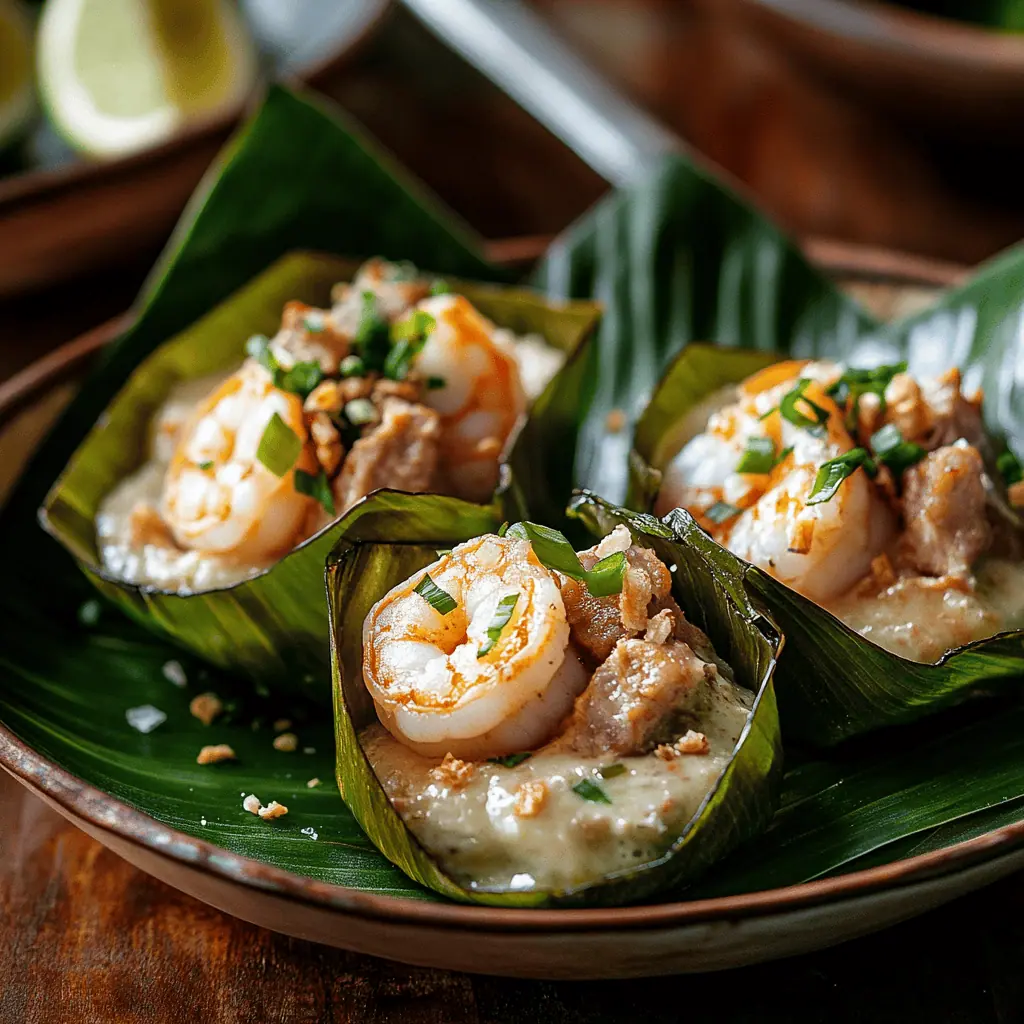
Why You'll Love This Recipe
- Authentic Filipino flavors passed down through generations
- Perfect balance of seafood and coconut
- Restaurant-quality dish you can make at home
- Impressive presentation for special occasions
- Natural cooking method that locks in flavors
- Sustainable cooking using traditional banana leaf wrapping
- Can be prepared ahead for gatherings
Ingredients
Each ingredient in Pinais na Hipon serves a specific purpose in creating this flavorful dish. Small suahe shrimp are chosen for their natural sweetness, while pork belly adds richness and depth. Young coconut meat provides texture and subtle sweetness that complements the seafood.
The aromatic base of onion and garlic creates a foundation of flavor, while shrimp juice intensifies the seafood taste. Coconut cream binds everything together with its luxurious richness. The banana leaves aren't just for wrapping, they infuse the parcels with a distinct herbal aroma that's impossible to achieve any other way.
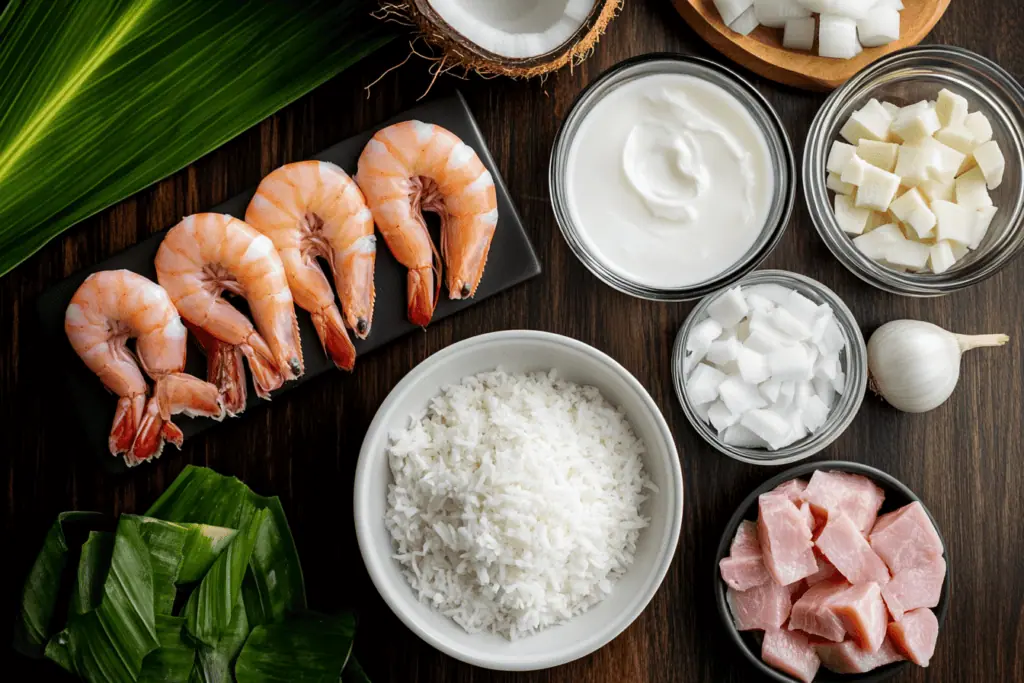
- 500g shrimp, preferably small suahe variety
- 250g pork belly, finely chopped
- 2 cups young coconut meat, freshly shredded
- 1 medium onion, finely chopped
- 4 cloves garlic, minced
- ¼ cup shrimp juice
- Salt and pepper to taste
- 2 cups coconut cream
- 6-8 banana leaves, cleaned and cut into 6-inch squares
- Kitchen twine or pandan leaves for tying
Equipment
- Large mixing bowl: For combining all ingredients thoroughly
- Mortar and pestle: Essential for extracting flavorful juice from shrimp heads
- Fine-mesh strainer: For straining the shrimp juice without any shell fragments
- Wide, shallow pan: Provides even heat distribution for gently simmering the parcels
- Sharp knife: For precise cutting of ingredients to ensure even cooking
- Measuring cups and spoons: For accurate ingredient portions
- Kitchen scissors: Makes cutting banana leaves into uniform squares easier
- Kitchen twine or pandan leaves: For securing parcels tightly during cooking
- Heavy-bottom skillet: Optional for charring parcels to add smoky flavor
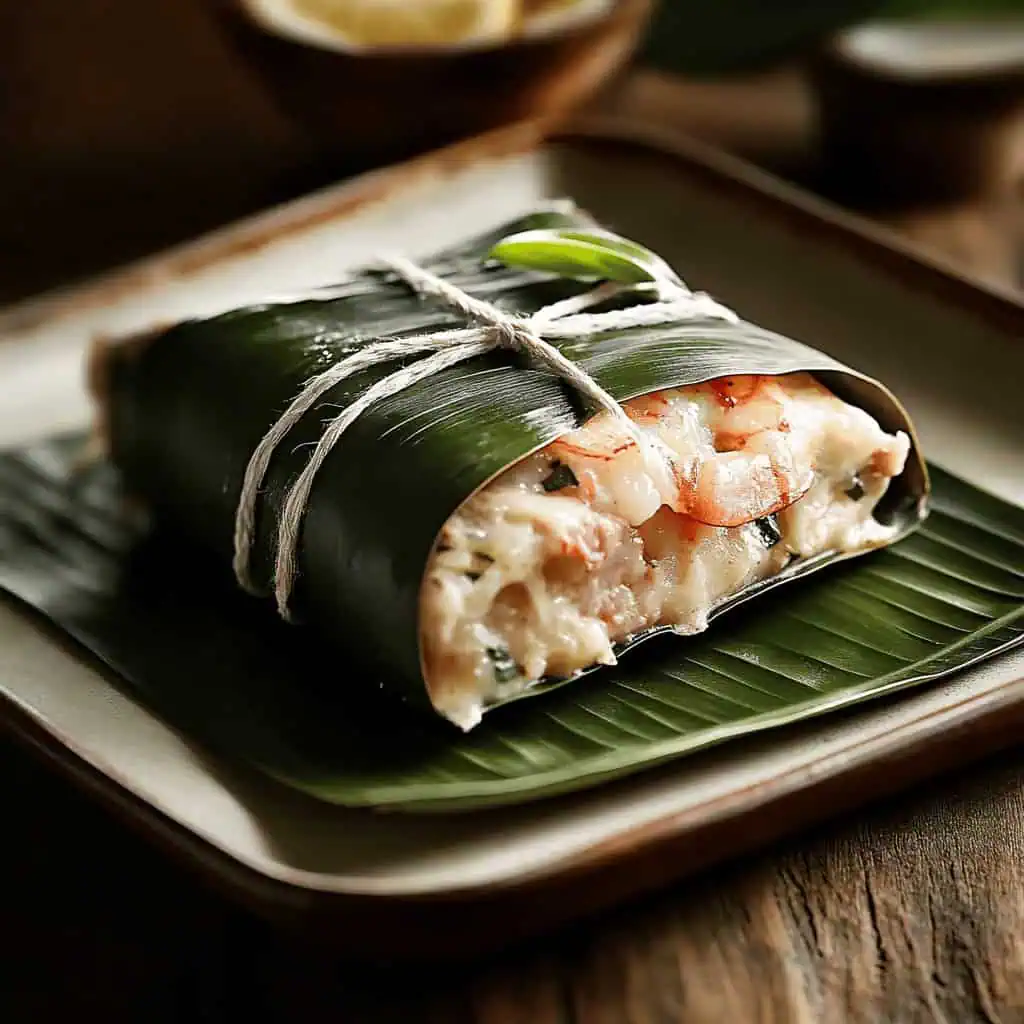
How to Make
- Prepare the banana leaves: Wash thoroughly and wipe dry. Pass quickly over flame to make pliable. Cut into 6-inch squares.
- Prepare the shrimp juice: Clean and peel shrimp, reserving heads. Pound shrimp heads with ¼ cup water. Strain through fine-mesh strainer.
- Make the filling: Chop shrimp into small pieces. Combine with chopped pork belly, shredded young coconut, minced garlic, and chopped onions. Add shrimp juice and season with salt and pepper.
- Wrap parcels: Place 3 tablespoons filling in center of banana leaf. Fold sides to form a secure packet and tie with twine or pandan leaves.
- Cook over medium-low heat (160°C/320°F): Arrange parcels in a single layer in pan. Pour coconut cream. Simmer gently for 20-25 minutes.
- Optional: Briefly char packets over flame for smoky flavor.
- Let rest for 5 minutes before serving. When reheating, steam for 8-10 minutes or until internal temperature reaches 165°F/74°C.

Tips from Lola's Kitchen
- Use freshly squeezed coconut cream whenever possible for the most authentic flavor. The difference between fresh and canned is remarkable in this dish.
- Monitor your heat carefully throughout the cooking process. Too high heat will cause the coconut cream to separate and curdle.
- Choose small, sweet shrimp (suahe) if you can find them. Their natural sweetness pairs perfectly with the coconut flavor.
- Double-check your wrapping technique before cooking. Secure parcels prevent leaking and ensure all the delicious flavors stay inside.
- Always allow the parcels to rest before serving. This extra 5 minutes helps the flavors settle and makes the parcels easier to handle.
- When selecting banana leaves, look for fresh, pliable ones without tears. If they're too stiff, they'll crack during wrapping.
- Save the coconut sauce after cooking. It's delicious drizzled over steamed rice or as a dipping sauce.
Substitutions
- No banana leaves? Use parchment paper or aluminum foil. You'll lose some of the traditional aroma but the dish will still be delicious.
- Can't find fresh coconut cream? High-quality packaged coconut cream works well. Look for brands without additives.
- No suahe shrimp available? Regular shrimp work fine when chopped into smaller pieces.
- Pork belly alternative? Ground pork provides similar richness with less fat.
- Fresh young coconut hard to find? Packaged young coconut strips can be used, but drain well first.
- No mortar and pestle? A food processor can extract shrimp juice, though the flavor will be slightly less intense.
Troubleshooting
Problem: Coconut Cream Curdling
- Solution: Keep temperature consistently low and never allow the mixture to boil. If curdling begins, immediately reduce heat and stir gently.
Problem: Banana Leaves Breaking
- Solution: Make sure to properly heat the leaves over a flame to make them pliable. If they're still breaking, use two overlapping leaves for strength.
Problem: Filling Too Wet
- Solution: Drain excess liquid before wrapping. If needed, add 1 tablespoon of cornstarch to the mixture to absorb excess moisture.
Problem: Parcels Unwrapping During Cooking
- Solution: Use kitchen twine to secure in multiple directions, or double-tie with pandan leaves.
Problem: Shrimp Cooking Unevenly
- Solution: Ensure all shrimp pieces are cut to similar sizes and distributed evenly throughout the mixture.
Storage & Reheating
- Refrigerate: Store in an airtight container for up to 3 days. Keep the parcels intact and refrigerate any leftover coconut sauce separately.
- Freeze: You can freeze the uncooked parcels (without sauce) for up to 1 month. Wrap each parcel in plastic wrap, then place in a freezer bag.
- Reheating from refrigerated: Steam parcels for 8-10 minutes until thoroughly heated. Alternatively, microwave with a damp paper towel covering them to maintain moisture.
- Reheating from frozen: Thaw overnight in the refrigerator first, then steam for 10-12 minutes. Always ensure the internal temperature reaches 165°F for food safety.
- Sauce reheating: Warm coconut sauce separately on low heat, stirring constantly to prevent separation.
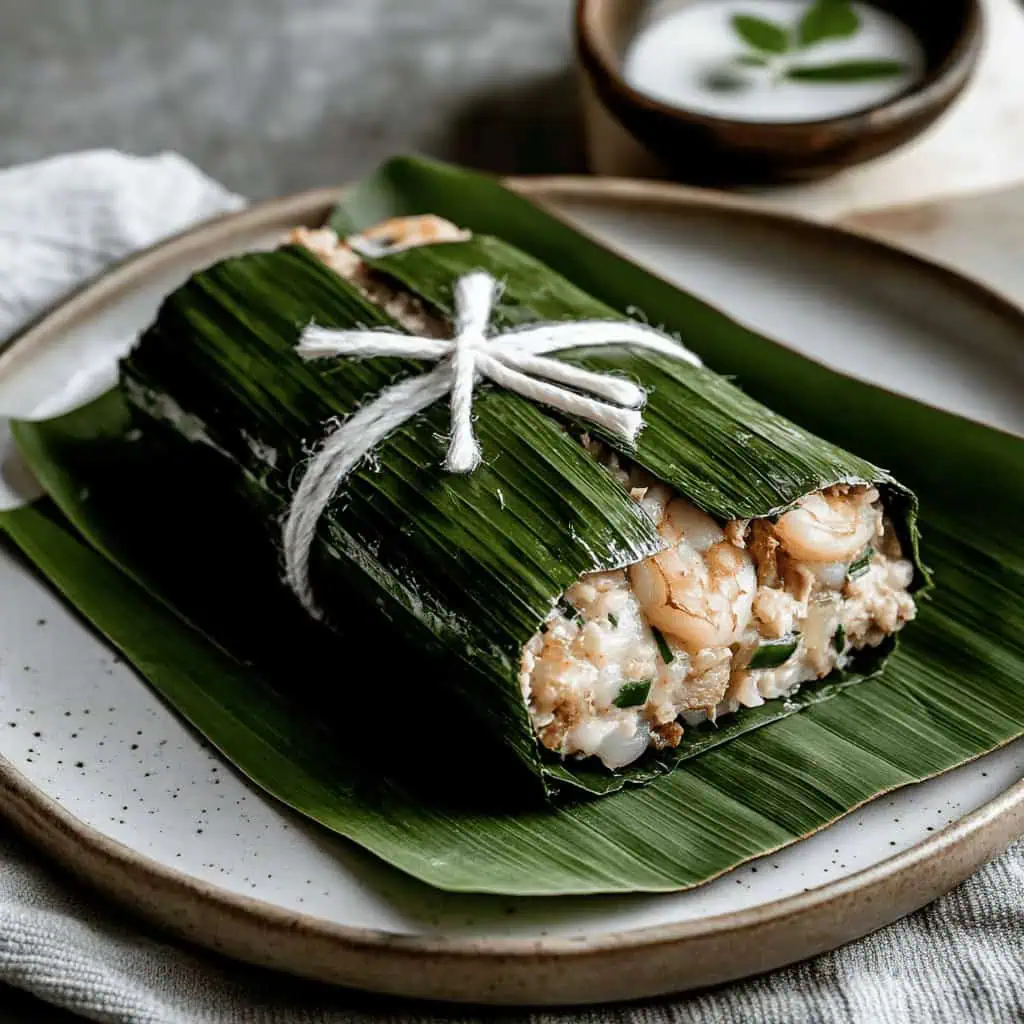
FAQ
Can I make this ahead of time?
Yes, you can prepare the parcels up to 24 hours ahead. Store them covered in the refrigerator and cook just before serving for best results.
How do I know when the parcels are fully cooked?
The shrimp should be pink and opaque, and the pork should be tender when pierced with a fork. The internal temperature should reach 165°F/74°C.
Can I cook this without pork?
Absolutely! You can make an all-seafood version by doubling the shrimp or adding other seafood like scallops or fish chunks.
What's the best way to make this for a large gathering?
Prepare all the parcels in advance and refrigerate. When ready to serve, you can cook them in batches or use a larger pot that can accommodate all parcels in a single layer.
How spicy is this dish traditionally?
The traditional version is mild with no chili heat. The flavor profile focuses on the natural sweetness of coconut and seafood.
Can I use coconut milk instead of coconut cream?
Coconut cream is preferred for its richness, but if using coconut milk, reduce it first by simmering until it reaches a thicker consistency.
What's the difference between Pinais na Hipon and Sinugno?
While both use banana leaf wrapping, Sinugno is typically grilled directly while Pinais is simmered in coconut cream.
Is this dish gluten-free?
Yes, the traditional recipe is naturally gluten-free, but always check store-bought ingredients for additives.
Related
Looking for other recipes like this? Try these:
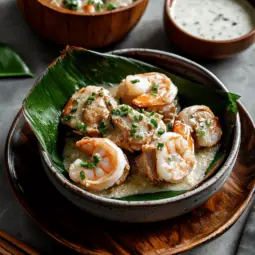
Pinais na Hipon (Filipino Coconut Shrimp Parcels)
Equipment
- Large mixing bowl (Kaldero o malaking mangkok) For combining ingredients
- Mortar and pestle (dikdikan) For extracting shrimp juice from heads
- Fine-mesh strainer (salaan) For straining shrimp juice
- Wide, shallow pan (Kawali) For gentle simmering
- Sharp knife (kutsilyo) For preparing ingredients
- Measuring cups and spoons (Panukat) For accurate measurements
- Kitchen scissors (Gunting) For cutting banana leaves
- Kitchen twine or pandan leaves (Pantali) For securing parcels
- Heavy-bottom skillet Optional for charring parcels
Ingredients
For the Filling:
- 500 g shrimp Hipon - preferably small suahe variety
- 250 g pork belly Liempo, finely chopped
- 2 cups young coconut meat Buko, freshly shredded
- 1 medium onion Sibuyas, finely chopped
- 4 cloves garlic Bawang, minced
- ¼ cup shrimp juice Katas ng hipon
- Salt Asin at Paminta to taste
For Cooking:
- 2 cups coconut cream Kakang gata
- 6-8 banana leaves Dahon ng saging, cleaned and cut into 6-inch squares
- Kitchen twine or pandan leaves for tying
Instructions
- Begin by preparing the banana leaves: Wash thoroughly and wipe dry (Hugasan at patuyuin). Pass quickly over flame to make pliable. Cut into 6-inch squares.
- At room temperature, prepare the shrimp juice: Clean and peel shrimp, reserving heads. Pound shrimp heads with ¼ cup water (Dikdikin ang ulo ng hipon sa tubig). Strain through fine-mesh strainer (Salain ang katas).
- Make the filling (Paggawa ng palaman): Chop shrimp into small pieces (Tadtarin ang hipon). Combine with chopped pork belly, shredded young coconut, minced garlic, and chopped onions. Add shrimp juice and season with salt and pepper (Paghaluin ang lahat ng sangkap at timplahan ng asin at paminta).
- Wrap parcels (Pagbabalot): Place 3 tablespoons filling in center of banana leaf (Maglagay ng 3 kutsarang palaman sa gitna ng dahon). Fold sides to form a secure packet and tie with twine or pandan leaves (Ibalot at talian).
- Cook over medium-low heat (160°C/320°F). Arrange parcels in a single layer in pan. Pour coconut cream (Ibuhos ang kakang gata). Simmer gently for 20-25 minutes (Pakuluan ng mahina ng 20-25 minuto).
- Optional: Briefly char packets over flame for smoky flavor (Maaaring ihawin sandali).
- Let rest for 5 minutes before serving (Palamigin ng 5 minuto bago ihain). When reheating, steam for 8-10 minutes or until internal temperature reaches 165°F/74°C (Kapag iinitin, pasingawan ng 8-10 minuto o hanggang umabot sa 165°F/74°C ang init sa loob).
Tips from Lola's Kitchen
- Use freshly squeezed coconut cream for best results
- Keep heat low to prevent coconut cream from curdling
- Choose small, sweet shrimp (suahe) for authentic taste
- Wrap parcels tightly to prevent leaking
- Let parcels rest for 5 minutes before serving
Nutrition
The Story Behind Pinais na Hipon (Filipino Coconut Shrimp Parcels)
Growing up in coastal Quezon province, my Lola always said that the best Filipino recipes come from necessity and abundance. Pinais na Hipon perfectly embodies this wisdom, born in the fishing villages where fresh shrimp was plentiful and coconut trees lined every shore. Local families would wrap the day's catch in banana leaves, a natural preservation method that became the foundation of this beloved dish.
What makes Pinais na Hipon (wrapped shrimp in coconut milk) special is its ingenious combination of the region's most abundant ingredients. The coastal communities of Quezon discovered that wrapping fresh suahe (small shrimp) with grated young coconut in banana leaves created a natural steaming pocket, intensifying the seafood's sweetness. Later, enterprising home cooks added chopped liempo (pork belly) to create a richer, more luxurious version that's now served in Filipino restaurants across the country.
The cooking method itself tells a story of Filipino ingenuity. 'Pinais' comes from the word 'pais', which means to wrap in leaves before cooking – a technique our ancestors used long before aluminum foil existed. This traditional preparation method doesn't just make the dish convenient to cook; it infuses the shrimp and pork with the distinct, subtle aroma of banana leaves while keeping the coconut cream from curdling, a secret that Quezon province's expert cooks have perfected over generations.
Today, this traditional Quezon delicacy remains a testament to Filipino coastal cuisine, where the bounty of both land and sea comes together in perfect harmony. Whether served at family gatherings, fiestas, or casual weekend meals, Pinais na Hipon continues to capture the hearts (and palates) of food lovers who appreciate authentic Filipino flavors and time-honored cooking traditions.
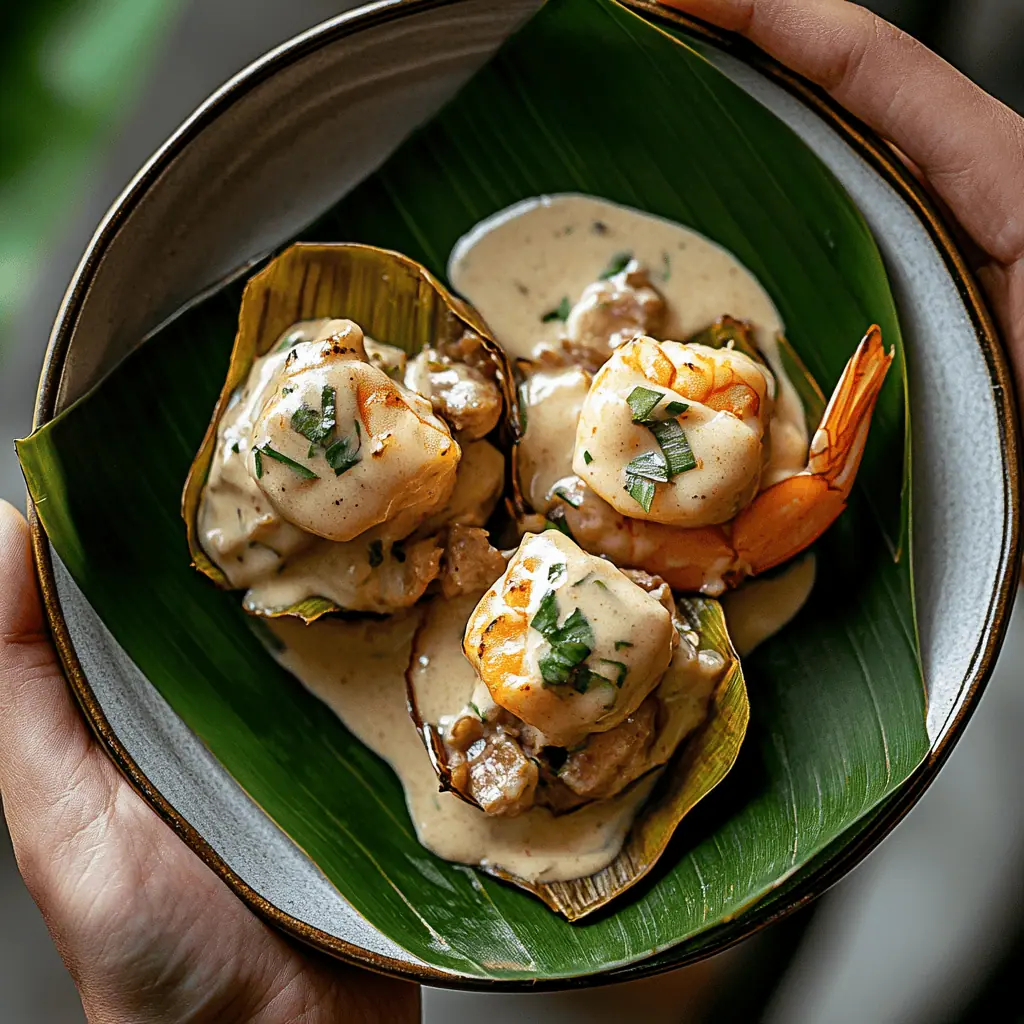









Comments
No Comments